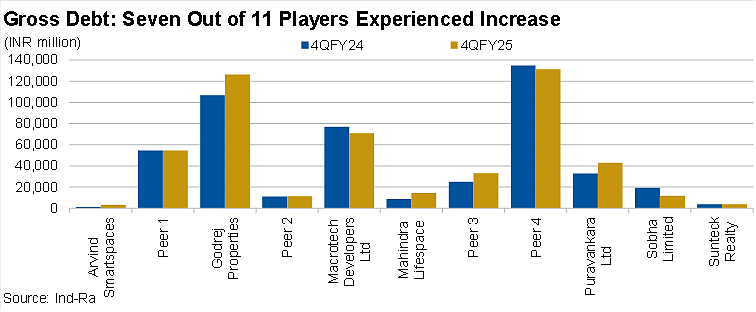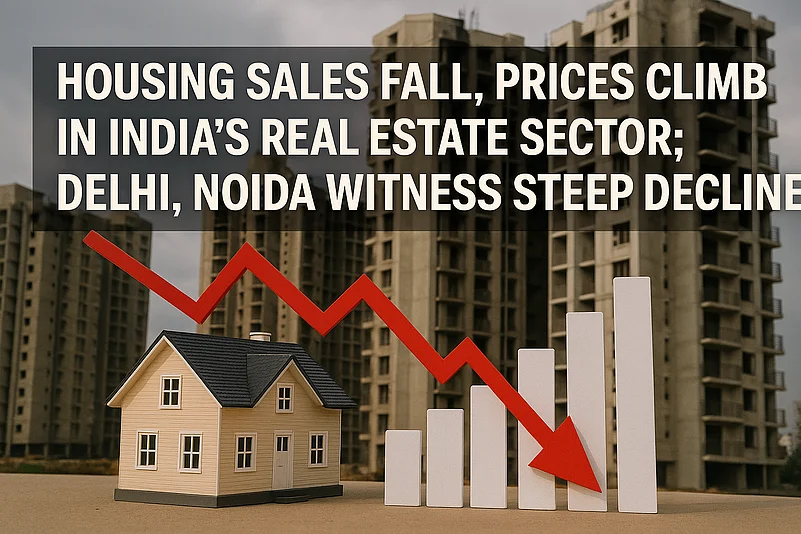India’s residential real estate engine, which has been racing for the last two financial years, is finally slowing down. After two years of bullish momentum, the brakes have come on hard in FY25. According to India Ratings and Research (Ind-Ra), Tier-1 developers saw a 6 per cent dip in sales volumes over the previous year. The March quarter alone clocked a sharper 13 per cent fall, a clear sign that the post-pandemic rally has lost steam.
The reasons aren’t mysterious. A high base from past years has made year-on-year comparisons tougher. Delays in new project launches have added to the drag. And yet, the picture isn’t entirely grim. Sales value actually went up by 9 per cent during the same period, thanks to stronger realisations and a better product mix. What’s selling now isn’t necessarily more homes but more expensive ones.
That’s the shift Ind-Ra is tracking. It expects booking value growth in FY26 to ease to the low or mid-single digits, after a 23 per cent jump this year. It’s not calling a crash yet but the headwinds are real. Policy stability, sector consolidation, and resilient demand in the mid-premium bracket might soften the blow, but the days of runaway growth are clearly over.

“Even though the volumes are in a negative zone and prices are still in the positive zone. So the net effect is that you still have some positive growth on the bookings,” said Mahaveer Jain, Director, India Ratings & Research, while speaking with Outlook Money.
“The mid-premium segment, homes priced between Rs 1 crore and Rs 2.5 crore has been particularly resilient. This seems to be a multi-year theme. Even if luxury slows down, the mid-premium segment will hold up. The recent reduction in policy rates should also help rekindle affordable housing demand.”
And it’s not just Tier-1 cities feeling the heat.
Magicbricks, in its Q1 2025 PropIndex, found that while demand across 13 major metros barely inched up just 0.6 per cent quarter-on-quarter prices kept climbing. They rose 2.8 per cent QoQ and a striking 21.7 per cent compared to last year. The national average now sits at Rs 12,829 per square foot. That might look like a win for developers, but buyers are starting to hesitate.
Demand has fallen sharply in key northern markets. Delhi saw an 11.9 per cent drop, Greater Noida 10.1 per cent, and Noida a steeper 12.5 per cent.
Meanwhile, growth pockets remain. Hyderabad posted a 7.5 per cent bump in demand, Bengaluru rose by 2.7 per cent, and Mumbai added 2.3 per cent. These cities continue to draw working professionals and first-time buyers, but proximity to jobs and infrastructure still matters.
At the same time, supply is flooding the market. Magicbricks recorded a near 40 per cent jump in under-construction inventory. Cities like Gurugram, Greater Noida, and Bengaluru saw a wave of new listings. Developers seem optimistic. Whether that optimism is warranted or will eventually pressure prices downward remains to be seen.
On possible reason for slowdown and bottlenecks in the real estate industry, Jain explained, “It’s not a funding or demand problem. The main challenges are cost inflation especially land prices and regulatory delays. Environmental clearances, for instance, are taking longer. In cities like Bengaluru, the e-Khata re-registration issue delayed many project approvals.”
Jain explained that India Ratings measures housing affordability by comparing how fast home prices are rising versus how fast people’s incomes are growing. In the past, home prices used to grow at about 80 per cent of the pace of wage growth, meaning incomes were rising faster, so homes stayed relatively affordable.

Now, that gap has closed. Prices are rising just as fast as incomes, a one-to-one ratio. This means affordability has tightened. Homes haven’t become unaffordable yet, but there’s less breathing room for buyers.
That’s why Jain believed developers can’t keep raising prices much more. At most, a 2–4 per cent price hike might still be absorbed by the market. Anything higher, he warned, could start pushing buyers away.
Real Estate Market in Tier II Cities
The story in India’s smaller cities is more layered. A fresh report from PropEquity shows housing sales in the top 15 tier-2 cities dropped 8 per cent in Q1 2025 compared to the same period last year. Yet again, value outpaced volume and total sales rose 6 per cent to Rs 40,443 crore.
Ahmedabad topped the list in both volume and value, selling over 14,500 units worth Rs 13,565 crore, despite a marginal 1 per cent drop in volume. Cities like Lucknow, Coimbatore, and Gandhinagar managed to grow their numbers, one of the few silver linings in an otherwise sluggish market.
“Demand in tier-2 cities remained robust as people have shown greater preference for organised living,” said Samir Jasuja, Founder and CEO of PropEquity. “Urban rejuvenation, improved connectivity, and the rise of IT and manufacturing hubs have accelerated demand from both local buyers and migrants.”
With the Reserve Bank of India cutting repo rates by 50 basis points since January 2025, and the market expecting more easing ahead, banks could soon pass on the benefit through lower EMIs. That could give fence-sitting buyers a reason to return in the months ahead.
Slowdown in New Launches
If the drop in sales isn’t enough, new launches will slow down, too. According to ANAROCK’s Q1 2025 data, sales across the top seven cities fell by a massive 28 per cent year-on-year. From over 1.3 lakh units sold in Q1 2024, the number dropped to 93,280 in the first quarter of this year. Hyderabad was hit hardest, down 49 per cent. Kolkata followed at 31 per cent, with Pune close behind at 30 per cent. Bengaluru, though still down, held firmer at 16 per cent.
Launch activity also shrank, down 10 per cent compared to last year. Cities like NCR, Bengaluru, and Kolkata still saw strong new supply, up 53, 27, and 26 per cent respectively. But Hyderabad tanked again, with new launches plummeting 55 per cent year-on-year.
Luxury Housing Market on Rise
What’s more telling is what kind of homes are being built. Nearly half of all new launches were in the luxury or ultra-luxury category, homes priced above Rs 1.5 crore. Affordable housing, by contrast, made up just 12 per cent of new supply. That imbalance is feeding the price surge. ANAROCK noted a 17 per cent average jump in residential prices across major metros. NCR led with a 34 per cent spike, followed by Bengaluru at 20 per cent. Even so, unsold inventory has edged lower down 4 per cent from a year ago. Pune cleared the most stock, while Bengaluru added to its pile. The southern IT hub saw unsold homes increase by 28 per cent, raising alarms about overbuilding in a market still digesting its last boom cycle.
"In terms of pricing, residential properties priced between INR 45 lakh and INR 1 crore are expected to remain the dominant category in 2025. However, increasing demand for homes in the INR 1 to 2 crore range signals evolving buyer preferences, driven by growing demand for more spacious homes, rising disposable incomes, etc. This trend is expected to support continued activity in the high-end segment, even within traditional mid-end-dominated markets, with homes in the INR 1 to 1.5 crore range likely to attract significant buyer interest. In addition, this evolving market dynamic is anticipated to reinforce further the growing propensity for bigger home loan ticket sizes," says, Anshuman Magazine, Chairman & CEO - India, South-East Asia, Middle East & Africa, CBRE.










